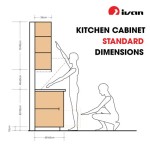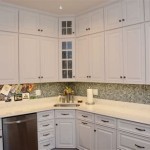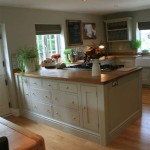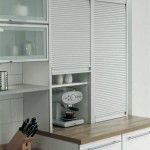Lacquer Kitchen Cabinets: Pros and Cons
Lacquer cabinets offer a sleek, modern aesthetic that can elevate any kitchen. However, like any design choice, they come with their own set of advantages and disadvantages. Understanding these pros and cons can help homeowners make an informed decision when selecting kitchen cabinetry.
Pros of Lacquer Kitchen Cabinets
Lacquer finishes offer several benefits that make them a popular choice for kitchen cabinets:
- High-Gloss Finish: Lacquer creates a distinctive high-gloss sheen that reflects light, making the kitchen appear brighter and more spacious. This glossy finish also contributes to a modern, sophisticated look.
- Durable and Moisture-Resistant: When properly applied and maintained, lacquer creates a hard, durable surface that is resistant to moisture, stains, and scratches. This makes it suitable for the demanding environment of a kitchen.
- Wide Range of Colors: Lacquer can be pigmented in virtually any color, allowing for a high degree of customization. Homeowners can choose from a wide spectrum of shades to achieve their desired aesthetic, from vibrant hues to subtle neutrals.
- Smooth and Seamless Finish: The lacquer application process results in a smooth, seamless surface, free from brushstrokes or texture. This contributes to the clean, modern look that lacquer is known for.
- Easy to Clean: The non-porous surface of lacquer makes it easy to clean. Spills and splatters can be wiped away with a damp cloth, simplifying kitchen maintenance.
Cons of Lacquer Kitchen Cabinets
Despite its advantages, lacquer also has certain drawbacks to consider:
- Higher Cost: Lacquer finishes are generally more expensive than other cabinet finishes, such as laminate or thermofoil. The multi-step application process and specialized equipment required contribute to the higher cost.
- Susceptibility to Chipping and Cracking: While durable, lacquer can be prone to chipping and cracking if subjected to significant impact. This is especially true for lower-quality lacquer finishes.
- Fading Over Time: Extended exposure to direct sunlight can cause lacquer finishes to fade or yellow over time. This is a particular concern for kitchens with large windows or skylights.
- Difficult to Repair: Repairing damaged lacquer can be challenging and often requires professional expertise. Touch-ups can be difficult to blend seamlessly with the existing finish.
- Strong Odor During Application: The application process involves strong solvents that release volatile organic compounds (VOCs). Adequate ventilation is essential during and after application, and the odor can linger for several days.
Factors Influencing Lacquer Cabinet Durability
Several factors can influence the durability and longevity of lacquer kitchen cabinets:
- Quality of Lacquer: Higher-quality lacquer typically contains more solids and fewer solvents, resulting in a harder, more durable finish.
- Number of Coats: Multiple coats of lacquer create a thicker, more protective layer, increasing resistance to damage.
- Application Technique: Proper application is crucial for achieving a smooth, even finish and maximizing durability. Skilled application minimizes the risk of imperfections and ensures proper adhesion.
- Maintenance and Care: Regular cleaning with a soft, damp cloth and avoiding harsh chemicals can help preserve the finish and extend the lifespan of the cabinets.
Comparing Lacquer to Other Cabinet Finishes
Understanding how lacquer compares to other common cabinet finishes can aid in the decision-making process:
- Lacquer vs. Laminate: Laminate is a more budget-friendly option, but it lacks the high-gloss sheen and smooth finish of lacquer. Laminate is also more susceptible to chipping and peeling.
- Lacquer vs. Thermofoil: Thermofoil offers a similar smooth finish to lacquer, but it is less durable and more prone to heat damage. Thermofoil is also limited in color options.
- Lacquer vs. Paint: Painted cabinets can offer a similar color range, but they typically lack the high-gloss finish of lacquer. Paint can also be more susceptible to chipping and wear.
Environmental Considerations for Lacquer Cabinets
The environmental impact of lacquer finishes should also be taken into account:
- VOC Emissions: Traditional lacquer finishes contain VOCs, which contribute to air pollution. Low-VOC or water-based lacquer options are available and are a more environmentally friendly choice.
- Disposal: Proper disposal of lacquer cabinets and materials is important to minimize environmental impact. Check with local regulations for appropriate disposal methods.
Maintenance and Care of Lacquer Kitchen Cabinets
Proper maintenance can extend the life and beauty of lacquer cabinets:
- Regular Cleaning: Wipe down cabinets regularly with a soft, damp cloth. Avoid abrasive cleaners or scouring pads.
- Spill Cleanup: Clean up spills immediately to prevent staining or damage to the finish.
- Avoid Harsh Chemicals: Use mild cleaners specifically designed for lacquer finishes.
- Protect from Heat: Use trivets or heat pads to protect the finish from hot cookware.
- Avoid Direct Sunlight: Minimize direct sunlight exposure to prevent fading and yellowing.

Pros And Cons Of Lacquer Kitchen Cabinets

Pros And Cons Of Lacquer Kitchen Cabinets

Pros And Cons Of Lacquer Kitchen Cabinets

Pros And Cons Of Lacquer Kitchen Cabinets

Reinvent Your Kitchen Cabinets With A Coat Of Gloss

Lacquer Kitchen Cabinets Pros Cons Finish Type Comparison

Lacquered Kitchen Cabinets What You Need To Know Oppein

Lacquered Kitchen Cabinets What You Need To Know Oppein

High Gloss Kitchen Cabinets Pros And Cons

Lacquer Kitchen Cabinets Pros And Cons L Shaped Design
Related Posts








